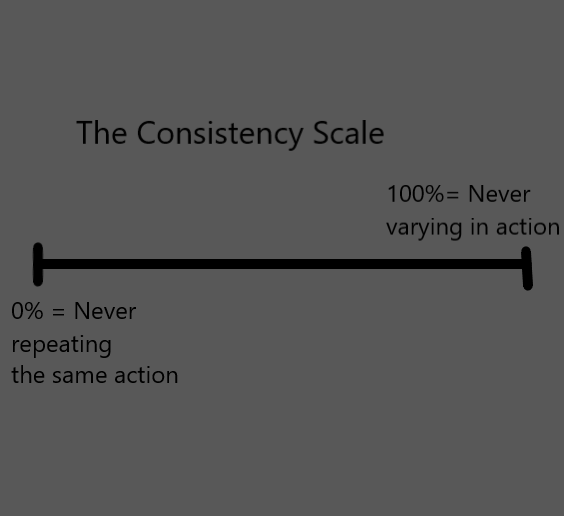Throughout my time coaching, I have received many questions on a variety of topics. Some of the most common include:
- How can I lose weight and keep it off?
- What can I do to improve back pain without it coming back the next day?
- How can I gain strength AND maintain it?
- What is the best exercise to gain muscle mass?
While there are differences in what is required to achieve each of the goals above, the skill of consistency is necessary to accomplish any of them, and lasting change.
Let’s start with a definition, what is consistency?
Meriam-Webster.com defines being consistent as, “Free from variation or contradiction, a steady continuity” (1).
In other words, it is regularly practicing actions that affect our health, wellness, and/or fitness goals.
There are many options in terms of how much consistency, where you fit on the scale below. Each of your workouts or nutritional habits may fit into either extreme or anywhere in between.

So, is there a “perfect” amount of consistency?
It important to first consider that the amount of consistency of health and nutritional practices will provide different results for different people. One analysis looked at 1,000 nutritional coaching clients and found that 10-49% consistency of practicing nutritional habits and workouts DID provide results (2). While more consistency showed bigger results, it shows that changing nutritional and movement habits to any degree does provide results.
Therefore, if results are what you are looking for, any change practiced consistently, even 10 % of the time, will help move you towards your goal.
In choosing your consistency goal, I suggest considering the following:
- What is attainable for you today, this week, for the next month?
- What is easy enough that on the worst day and/or week you can still do it?
Asking these questions will allow you to see what will work for you over time, which, as shown above, is much more important in seeing sustainable change.
But… how do I build consistency?
There are two different aspects that I have found helpful in building consistency and integrating new practices.
- Structure: To construct/build a pattern or organization
- Flexibility: A willingness to change or compromise
While these two aspects differ greatly, one being rigid (structure) and one being fluid (flexible), finding a balance between these two is often very helpful to build consistency.
The structure provides an outline or plan to build consistency, while flexibility allows for life to happen and maintain consistency.
Let’s start with two stories…
Imagine a man, Joe, who wants to lose weight and improve his overall wellbeing. He decides he is going to work out Monday thru Friday every week before work. He does well the first week, but during the second week something comes up that he is unable to adjust. Joe misses a workout. Now in a plan that is high in structure without flexibility, missing the workout can feel like failure to follow the plan. Joe may feel badly about missing the workout and decides he may as well just quit now.
Our second example is Mary, a woman in her 20’s who wants to improve her cardiovascular health to join friends on a backpacking trip to the Grand Canyon this summer. Mary doesn’t create any structure; she decides she will work out more. On the first day, she gets distracted and decides she will start the next day. As the days go by and time goes on Mary forgets about the goal. Eventually summer arrives without Mary working out at all before hiking season.
While these examples are extreme, one or both may sound familiar to some degree.
So, how can we find a balance between?
I suggest trying to build structure with flexibility, setting up a target range to stay in. This allows for life to happen, while still maintaining some consistency.
How might this look within health and fitness goals?
First, setting up the right balance looks different for:
- Different people
- Different parts of your life
- And maybe even, different parts of the year
And that’s totally ok!
Some examples of structure with flexibility include:
- Exercising 1-4 times a week
- Eating vegetables 5-10 meals a week
- Exercising 5 days a week, without the structure of that days you exercise

Finding your sweet spot…
Meeting health and fitness goals requires consistent changes in behaviors and choices.
For some, structure may be useful for consistency, a very specific plan may feel good AND help you to be consistent.
For others, more flexibility may be helpful to feel like you can adjust around other things that are important to you without guilt or shame.
I think the most important aspect is not where you land on this scale, but what is useful for you.
- How much structure is helpful?
- At what point does structure become harmful to your goals?
- This may look like guilt, shame, or anger if unable to complete the planned activities.
- How much flexibility is helpful?
- At what point does flexibility become harmful to your goals?
- This may looks like being pulled away to do another activity so regularly that habits and behaviors do not change over time.
So, what does this look like for you?
Try the following structure below:
- Define a goal.
- Define a practice and/or habit you want to work on to move you towards this goal.
- Define some parameters. What is the minimum and maximum?
- Practice and see how it works!
Try it out and let me know what you think below, OR
Interested in a coach to help build new habits? Check out online training options here or find my contact information here.
Resources: